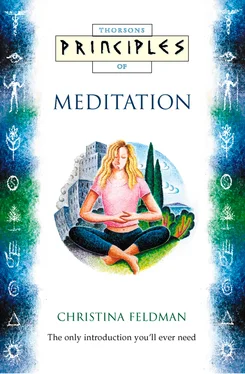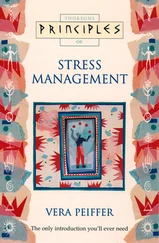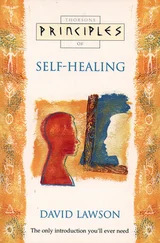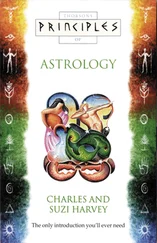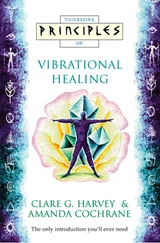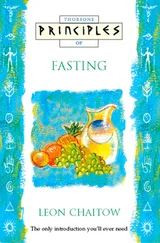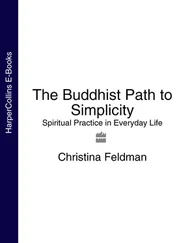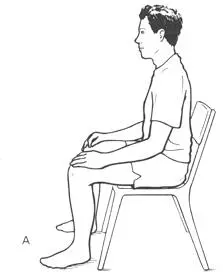
Sitting postures appropriate for meditation
A TEACHER
Again, differing degrees of emphasis are given to the significance of having a teacher or guide within the variety of meditative traditions. A teacher will offer more than just instruction in technique or form, but will serve as a spiritual friend able to offer guidance and experience. Some meditators find it helpful to connect with a teacher on an ongoing basis and as our meditation deepens the support of someone who has travelled this path before us can be invaluable. However, a relationship with a teacher is not a prerequisite to cultivating a meditation practice. If you bring to your meditation practice the willingness to learn, to deepen in sensitivity and patience, and the commitment to developing attentiveness, you have everything you need to begin.
In the following chapters the major styles of meditation will be explained. Feel free to experiment with and explore any of them until you find a style you feel some rapport with.
Beginning to Meditate
1 Choose a regular time – morning, evening, or whenever you can rely upon not being interrupted.
2 Find a place – as secluded, simple and quiet as possible.
3 Choose a posture that is comfortable for you.
4 Set a minimum time for your meditation, whether it is 15, 30 or 45 minutes.
5 Check your body for any apparent areas of tension and consciously relax.
6 Take a few deep breaths.
7 Begin.
Within the variety of schools of meditation there is agreement upon the need to cultivate a strong basis of attentiveness or concentration for the development of any style of meditation. Some disciplines will develop concentration as their primary form of practice, whereas other styles will emphasize developing only enough concentration to serve as a foundation for insight, contemplation or devotion. The need to retrain our attention as an essential ingredient in transformation is the central, prevailing thread that runs through the entire variety of meditative disciplines. For depth, balance and understanding a clear and calm attentiveness must first be present.
There are a whole range of experiences that are possible within the field of concentration that run from the simple capacity to keep ourselves focused in the present moment upon a single subject without distractedness, to profound altered states of consciousness that bring with them experiences of bliss, oneness and absorption in which the activities of the body and mind are stilled. Visionary experiences and feelings of deep rapture, joy and equanimity are all experiences that emerge from deep levels of concentration. Within this whole spectrum of experience the essential benefits of concentration to steady and calm the mind and establish us in the present moment are recognized.
Through developing concentration the mind is brought to rest in the present moment and deepening levels of calm pervade both mind and body. Through focusing our attention upon a single object there is an integration of the mind, body and present moment, and our capacity to attend to one moment at a time with clarity and sensitivity is enhanced. We are enabled to attend to the inner landscape of sensations, thoughts and feelings that is revealed to us free of our usual habitual reactions of judging or resistance. The concentrated mind has the power to penetrate deeply into the processes of our minds and bodies and to explore with ease other dimensions of meditation. Concentration enables us to cut through the habits of restlessness, discursive thinking and reactions that entangle us and set our minds in motion; the mind becomes tranquil and serene.
Through both fairly shallow and very profound states of concentration there are a number of insights that can emerge that bring deeper levels of happiness, harmony and freedom into our lives. In the calm and serenity that develop through concentration practice we discover subtle yet pronounced levels of happiness that are qualitatively different than the fleeting states of happiness or pleasure we find through excitement, achievement or possession. It is an inner happiness and contentment that depends on nothing outside of ourselves bringing with it a greater sense of inner completeness. This understanding changes our relationship to the world around us, enabling us to let go with greater ease and step back from the relentless pursuit of consumption, attainment and possession. Resting within an inner serenity and richness we are less inclined to search the world for the happiness we feel to be missing inwardly. We learn to be at ease within ourselves and within each moment – we find ourselves in greater harmony with the world around us and with other people. Through the development of concentration the mind becomes less fragile and susceptible to extremes. It becomes steady and balanced – able to receive the variety of experiences and impressions that come to us in life without feeling overwhelmed or burdened.
Concentration practice greatly enhances inner confidence as we improve in the art of attending wholeheartedly to one moment at a time. We develop our inner resources of energy, attentiveness and dedication and through collecting and directing them towards the present moment or a single subject of meditation we discover the calmness and clarity born of our own efforts. In becoming increasingly familiar with deeper levels of calmness the mind loses its addiction to busyness and entanglement. There is a lessening of interest in fantasy and daydreams that offer limited satisfaction in the light of a calm and clear attentiveness. Anxiety and stress levels decrease as they are supplanted by deepening levels of well-being and serenity. The inner tranquillity that emerges enables us to respond more intuitively and clearly both to our inner and outer world rather than being compelled by habitual reaction. The nature of the mind changes through concentration practice and our sense of the possibilities that lie within our consciousness expands.
Concentration is a means of simplifying our inner landscape. Rather than experiencing ourselves as being a captive of the endless stream of random thoughts, memories, plans and images that pass through our minds, concentration frees us from entanglement. As our attention deepens the thoughts begin to slow down and become clearer to us. We find an increasing capacity to be able to let go of the mind’s dominance and a deeper quality of calmness and clarity begins to emerge. We are aware of thinking, aware of the beginnings and endings of thoughts with a calm and clear attentiveness. Agitation is replaced by calmness, habit replaced by sensitivity and confusion gives way to clarity.
Concentration is developed through focusing the mind upon a single subject. Through this attentiveness the mind is united with the present moment. The subject that is chosen for attention will differ according to the meditation style, it can be a visual object, a sound or the breath, but the objective of sustaining a focus remains the same. The intention is to cultivate an undistracted and undivided attentiveness. The subject that is chosen serves as a steady anchor, a lifeline amidst the swirls of thoughts, images and sensation. It is a place we continually and gently return to each time we become lost or entangled in the streams of activity that pass through our minds. The sustaining of the focus upon a single object requires both perseverance and patience as we are faced again and again with the habitual wandering of the mind as it departs into past and future. We are facing the habit of distractedness that has perhaps accompanied us through our lives. It is not willpower or striving that enables us to penetrate this habit but practice, consistency and the right spirit of dedication and acceptance. Meditation is an art and like the exploration of any other discipline it requires love, the willingness to learn and the capacity to accept the moments we falter.
Читать дальше
